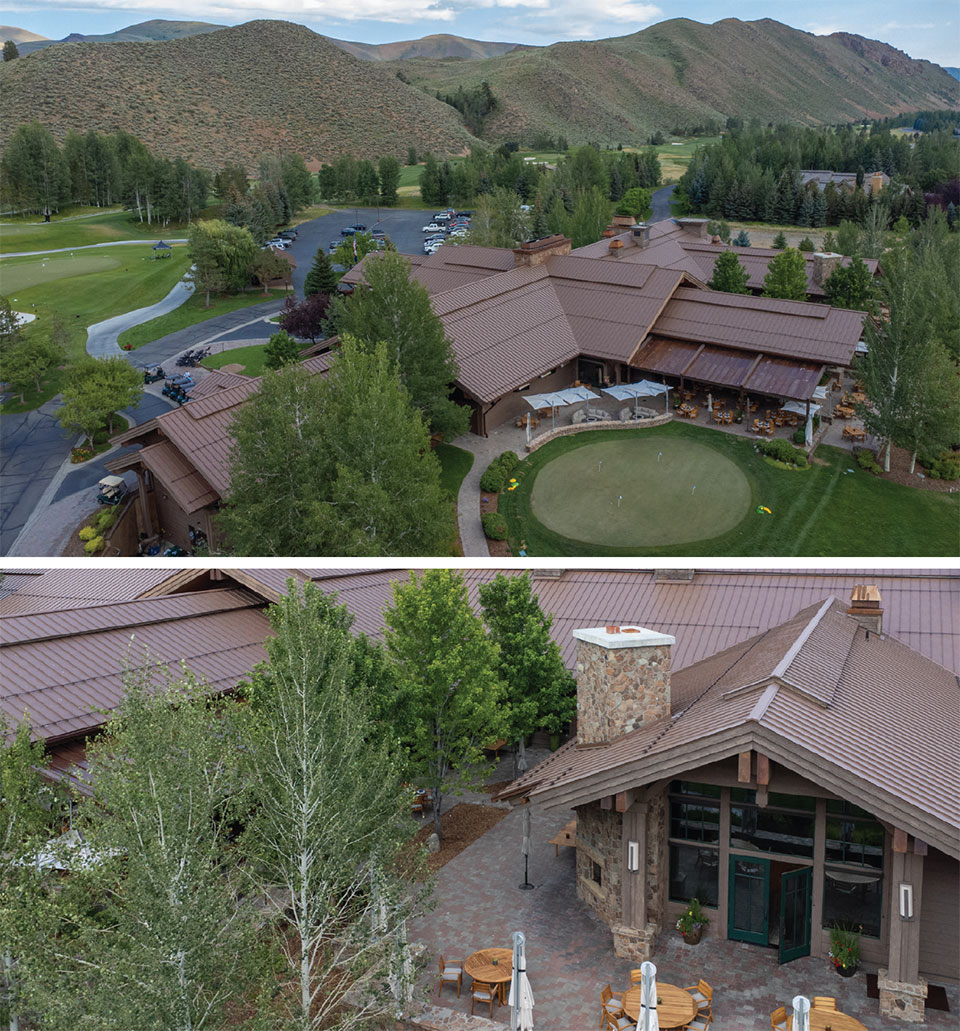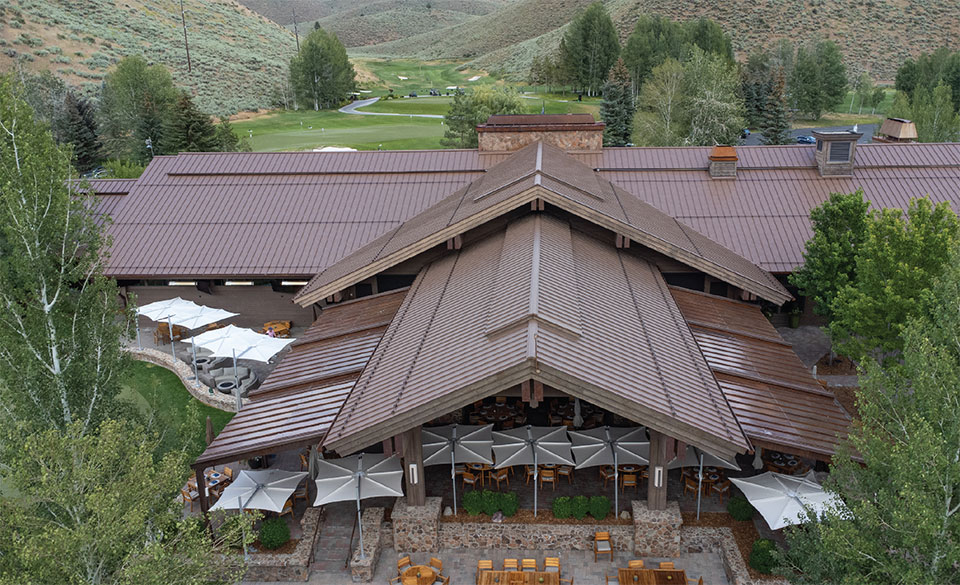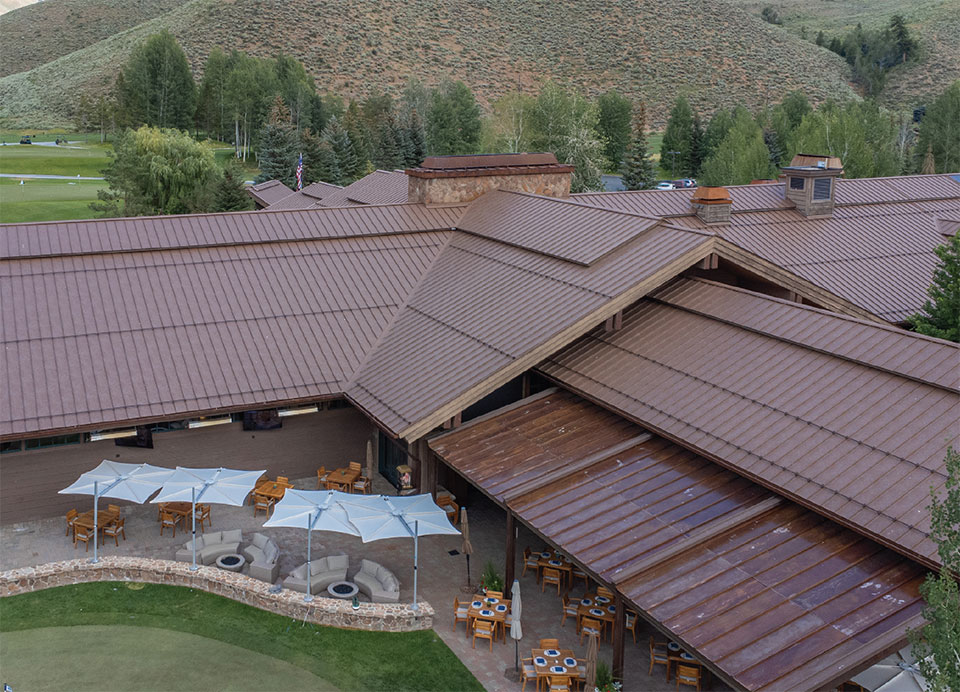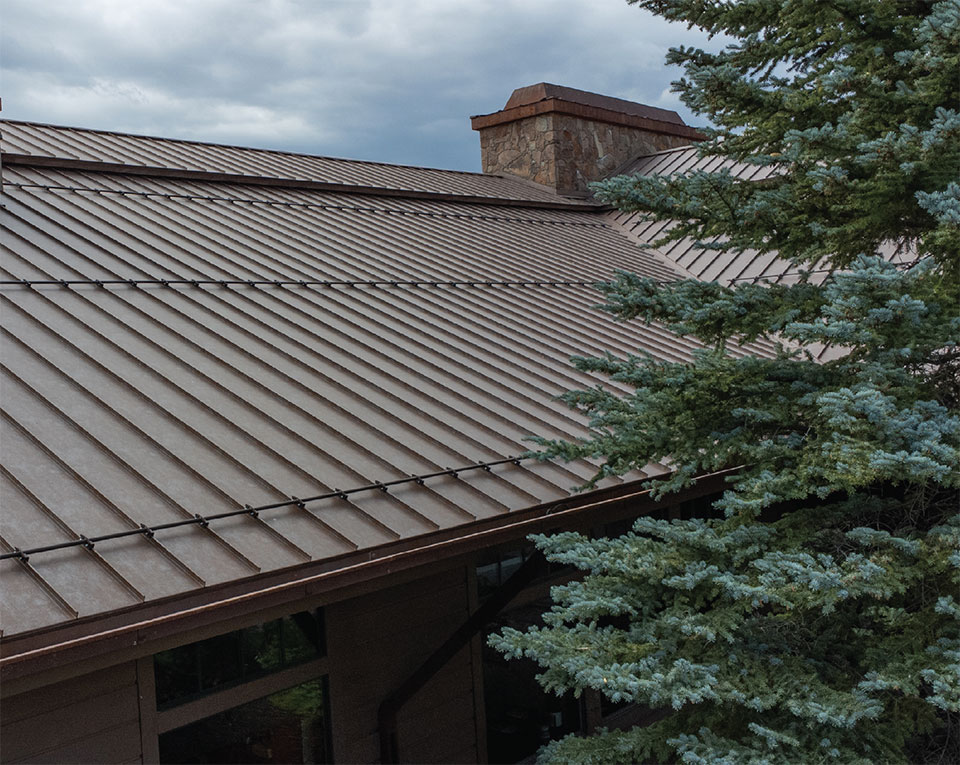Metal’s Many Possibilities
by Brian Libby
“We call it architectural-scale jewelry. You can’t use off-the-shelf pieces to create these projects.”
–Troy Quesnel, Owner, Miley Roofing
In the Wood River Valley of central Idaho, Miley Roofing has become a regional leader in what some in the business refer to as “architectural-scale jewelry” — custom metal roofs and architectural details that combine necessary durability in this snowy climate with matchless craftsmanship.
In business for over 30 years, Miley’s longevity comes from not only its craftspersons and track record but also from partners like The Bryer Company. Based in Auburn, Washington, just south of Seattle, Bryer has been providing the construction industry with architectural and commercial metal roof systems, wall and soffit panels, flat sheet and coil, and related accessories since 1985. The company’s array of custom colors, heavy gauges, and non-standard materials is unique in the marketplace.
“The Bryer Company provides us these goods that allow Miley Roofing’s skilled craftspersons to take an architect’s drawings and turn it into somebody’s home, or workplace, or the place they get away to,” says Miley Roofing owner Troy Quesnel. “Sometimes their products are used in a very standard fashion, as standing-seam metal roofs. Other times they’re used as building accents, whether it’s fascia pieces or siding. They can pretty much do it all.”

“Rusty metal really fits in with the architectural look of our mountain region, but you’ve got golfers walking in and out in their white pants and nice white shoes. Actual rusty metal is going to drip and stain. But this series doesn’t have that problem.”
–Troy Quesnel, Owner, Miley Roofing
At the Valley Club in Sun Valley, for example, a recent re-roofing project made use of Bryer’s state-of-the-art Natural FX coatings, which offer patterned multi-coat finishes with unparalleled detail and subtle depth. The club’s main clubhouse, dining room, and pro shop all sit under one wood roof, which needed to be replaced. The job also had to be completed within a tight window of time, beginning after the harshest winter days had passed but before the club opened for spring. The existing wood roof had been accented with metal that had long since oxidized into a handsome patina, which the client sought to replicate. That’s why they chose Bryer’s FX Iron Oxide color for the club’s new metal roof.
“Rusty metal really fits in with the architectural look of our mountain region,” Quesnel explains, “but you’ve got golfers walking in and out in their white pants and nice white shoes. Actual rusty metal is going to drip and stain. But this series doesn’t have that problem.”
“This Natural FX Iron Oxide that Miley Roofing did on the Valley Club looks amazing,” agrees Tom Van Alstine, The Bryer Company’s sales director. “I keep a sample in my office here. When people walk in, they say, ‘This rusted really nice.’ And I say, ‘No, it’s actually painted. It’s finished that way.’”

The project could have utilized a number of different Natural FX colors available from Bryer. Coal Creek, for instance, “is very popular around here: this beautiful dark gray, almost black-finished metal,” Quesnel says. “And we’ve often used Pine Bronze, which mimics plate-steel; it’s also been adopted by architects around here. We can create accent wall panels and fascia pieces that maybe they wouldn’t be able to do cost-effectively with eighth-inch or quarter-inch plate steel.”
Today, metal roofs are available in a wider variety of looks, patterns, and finishes than ever before, thanks to a new generation of technology. “You get more and more fine details,” Van Alstine explains. “The sky’s the limit.” This variety has enabled The Bryer Company to grow in parallel with increasing demand. “We’re just doing projects all over the place,” he adds.
The Bryer Company’s portfolio includes single-family homes and apartment buildings, elementary schools and colleges, resorts and restaurants. Van Alstine also recalls two recent projects that utilized Bryer roof systems in harsh climate conditions. The Diomede School on Little Diomede Island off the coast of western Alaska used an aluminum panel to withstand the corrosive saltwater environment there. The Oregon State University’s Gladys Valley Marine Studies Building, in coastal Newport, Oregon, incorporated zing roofing and siding to withstand high winds, heavy rains, and salty air. “You get 130-mile winds rushing through there,” Van Alstine says of the OSU project.
The most common metal roofs are made of steel, followed by aluminum, zinc, and copper; occasionally roofs are also made from stainless steel. “We can even bring in pre-patinaed copper where it’s already green,” Van Alstine adds. “If you can imagine it, and we can bend it, we can do it.”
Yet when it comes to making metal roofs a reality, it’s still about the execution. “It’s not necessarily new technology, but it’s a rare skill,” Van Alstine says. “We send them raw material in the widths that they need. And then they bring the craftsmanship.”

“This Natural FX Iron Oxide that Miley Roofing did on the Valley Club looks amazing. I keep a sample in my office here. When people walk in, they say, ‘This rusted really nice.’ And I say, ‘No, it’s actually painted. It’s finished that way.’”
–Tom Van Alstine, The Bryer Company, Sales Director
When the material arrives on trucks in 2,400-pound coils, Miley Roofing uses a combination of machine and hand tools—roll formers, benders, shears, hand tools, hammers—to form that metal into these finished products. “We call it architectural-scale jewelry,” Quesnel says. “You can’t use off-the-shelf pieces to create these projects. It is fairly efficient because we can take all that tooling to the jobsite and we can tailor most of the roof there. Then when we get to other architectural details like fascia, siding, wrapping corners; they’re coming back to the shop and building these pieces, then trimming and finessing them back in the field.”
Metal roofs comprise almost half of Miley Roofing’s business, mostly high-end residential, from roofing to fascia, siding, and flashings. “It’s being used more and more because we can do really cool things with our forming techniques to give you this very elegant, put-together look,” Quesnel says. “When you couple that with how durable and low-maintenance the material is, it’s no wonder metal is increasing in popularity year over year.”
